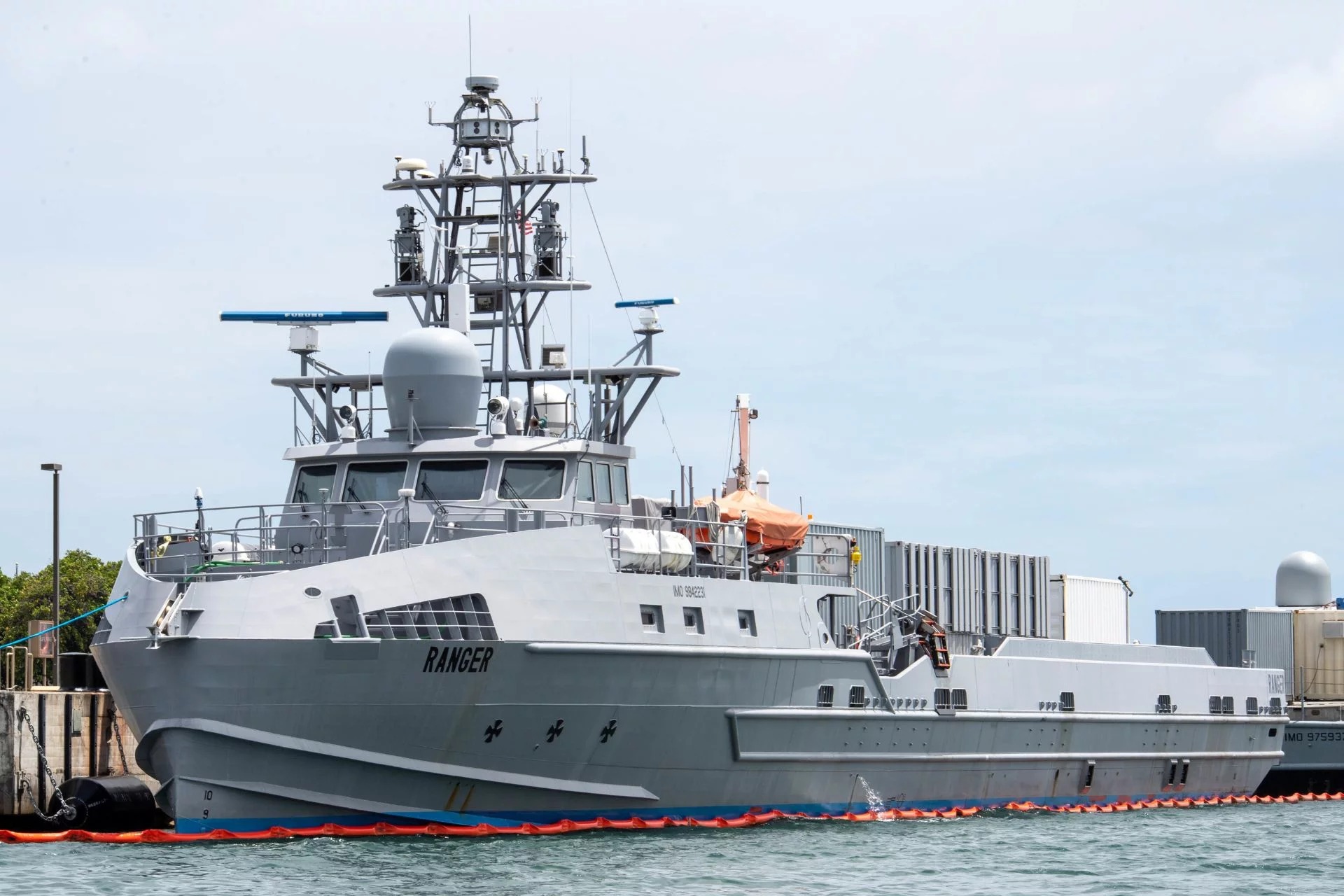The large unmanned surface vessel Ranger was docked at Joint Base Pearl Harbor-Hickam for the 2022 Rim of the Pacific (RIMPAC) exercise. (Photo credit: US Department of Defense)
As tensions simmer in the South China Sea and the broader Western Pacific, the U.S. Navy is making a monumental shift. It’s not just a change in tactics but in the very composition of its fleet, embracing a future dominated by unmanned vessels capable of operating in some of the world’s most contested waters. This transformation is driven by a straightforward yet audacious goal: maintain maritime superiority against increasingly capable adversaries like China, without putting American sailors directly in harm’s way.
The shift towards these ghost vessels isn’t just an experiment—it’s becoming the backbone of the Navy’s strategy to ensure it can operate anywhere, even places where enemy missiles and mines make the sea too perilous for manned ships. According to a recent Congressional Research Service report, the Navy’s 2025 defense budget requests funding for three major unmanned programs: the Large Unmanned Surface Vehicle (LUSV), Medium Unmanned Surface Vehicle (MUSV), and Extra-Large Unmanned Undersea Vehicle (XLUUV), also known as Orca.
These new crafts are technological marvels. The LUSV, envisioned to be between 60 and 90 meters long, mimics the capabilities of a small warship. It’s designed to carry vertical launch systems with 16 to 32 cells for anti-ship and land-attack missiles, potentially easing the operational load on the Navy’s traditional destroyers and cruisers. With $54 million earmarked for the LUSV program in the upcoming fiscal year and full-scale production slated to start in 2027, these vessels could soon be a common sight in strategic waterways.
Meanwhile, the smaller MUSVs are tailored for intelligence, surveillance, and reconnaissance missions, able to operate close to enemy coastlines with a lower risk of detection. These vessels, less than 60 meters in length and displacing under 500 tons, will complement the larger LUSVs by providing critical data and acting as a forward sensor array. The Navy has poured $101.8 million into developing technologies that will support both MUSV and LUSV capabilities.
Below the waves, the Orca XLUUVs are set to redefine undersea warfare. These large drones, capable of deploying seabed mines like the modernized Hammerhead—an anti-submarine torpedo system—offer a sneak peek into the future of naval combat. Tasked with laying mines and performing reconnaissance, the Orca reflects a strategic pivot towards unmanned undersea capabilities that can protect surface fleets and chokepoints without risking crewed submarines. Despite industrial setbacks that delayed its first delivery until early 2025, the program has resumed, with each unit costing up to $120 million as production ramps up.
But transitioning to a fleet replete with unmanned systems is not without its challenges. The very concept of how these unmanned vessels will integrate with manned units remains partially defined. Issues such as autonomy, command and control, and interoperability with traditional ships are complex puzzles the Navy is still piecing together. Moreover, reliance on sophisticated software and electronics heightens the risk of cybersecurity threats, a concern that cannot be overstated in an era where digital warfare is as decisive as the physical.
Critics within the Navy have voiced concerns, pointing to the LUSV’s burgeoning costs and complexity. Originally touted as a model of simplicity and mass production, some fear it’s straying from its initial promise. The Orca program, too, has seen its budget swell by 64 percent over initial estimates, highlighting the financial gamble the Navy is taking with these advanced systems.
Despite these hurdles, the strategic rationale for these investments is clear. In an environment where adversaries are rapidly improving their anti-access and area denial capabilities, the U.S. Navy’s move towards a more distributed, technology-driven force structure is a calculated risk. By deploying a mix of manned and unmanned platforms, the Navy aims to maintain flexibility and resilience, ensuring it can respond swiftly and effectively to threats without exposing crewed ships to undue risk.
This strategy is not merely about keeping pace with technological trends but about staying ahead of potential conflicts. As nations around the globe enhance their naval capabilities, the U.S. Navy’s commitment to unmanned technologies is both a defensive measure and a signal to adversaries that it remains a step ahead in the perpetual chess game of maritime strategy.
The success of these unmanned systems will hinge not just on technological advancements but on the Navy’s ability to integrate these new tools into its operational doctrine. As these vessels prepare to navigate the complex waters of modern naval warfare, their deployment will test not only the capabilities of the technology itself but also the strategic foresight of the Navy’s leadership. If successful, these unmanned vessels will not only extend the reach of U.S. naval power but also redefine the nature of maritime conflict in the 21st century.


